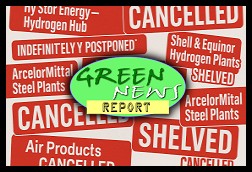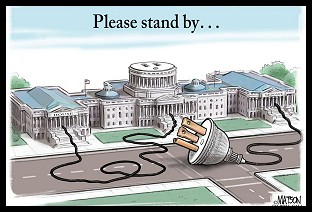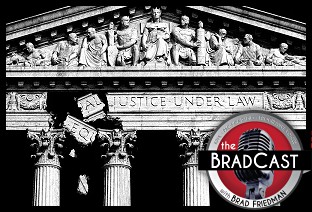
 Welcome aboard MORE new affiliates! Bob Kincaid's Head-On Radio Network joins the GNR team!
Welcome aboard MORE new affiliates! Bob Kincaid's Head-On Radio Network joins the GNR team!
IN TODAY'S AUDIO REPORT: Florida homes stink!; FDA under fire (again); McDonald's may reduce pesticides in fries; PLUS: The cardboard box that could save the world; And the Utah college student indicted for saving public lands from destruction...All that and more in today's Green News Report!
Got comments, tips, college student indictments? Drop us a line at GreenNews@BradBlog.com or right here at the comments link below. All GNRs are always archived at GreenNews.BradBlog.com.
IN 'GREEN NEWS EXTRA' (links below): Alaskan volcano still threatens oil facility; Are America's suburbs in danger of becoming the new slums?; the Oil Price Shock of 2008 may have triggered the current economic downturn; Robert Redford confronts the NIMBY problem in renewable energy sites....See below for more!
Info/links on stuff we talked about on today's episode, plus MORE green news, all follows below...
- U.S. Food Safety No Longer Improving
- Consortium rejects FDA claim of BPA's safety; Scientists say 2 studies used by U.S. agency overlooked dangers
- Babies carry more BPA, scientists group agrees
- SPECIAL INVESTIGATION: Chemical Fallout: A Journal Sentinel Watchdog Report
Warning: Chemicals in the packaging, surfaces or contents of many products may cause long-term health effects, including cancers of the breast, brain and testicles; lowered sperm counts, early puberty and other reproductive system defects; diabetes; attention deficit disorder, asthma and autism. A decade ago, the government promised to test these chemicals. It still hasn't. - AP IMPACT: Chinese drywall poses potential risks
- Chinese Drywall and the Cost of Truth-Telling
- McDonald's aims for a low-pesticide potato for its french fries
- McDonald's to take steps to cut potato pesticides
- Environmental activist indicted for making false bids
- UT Student Tim DeChristopher Indicted!
- Democracy Now!: Utah Student Who Prevented Bush Administration Sell-Off of Public Land Charged for Disrupting Auction
- Drilling Leases Scrapped in Utah
- Opinion: Oil lays waste to the West:
On election day, the Bureau of Land Management in Utah quietly announced its last round of oil and gas lease sales for the year. On Dec. 19, close to 400,000 acres of America's redrock wilderness --- much of it adjacent to Arches and Canyonlands national parks and Dinosaur National Monument --- were to be sold for drilling to the highest bidders.
Public outcry was fierce. The National Park Service had not been consulted, as it usually was, and much of the land listed for auction had long been proposed for wilderness protection. - FOR MORE INFO and to DONATE: Tim DeChristopher Legal Defense fund, via Paypal or snail mail
'GREEN NEWS EXTRA': More green news not covered in today's audio report... Alaskan volcano still threatens oil facility; Are America's suburbs in danger of becoming slums?; States consider making energy efficiency upgrades mandatory on new homes; the Oil Price Shock may have triggered the economic meltdown; Robert Redford has a on the competing needs of endangered species vs. renewable energy development on public lands...
- NASA Photo Reveals Drift River Terminal in Jeopardy
- Suburbs - our new slums? The burbs are in decline as more poor move out from the cities and more suburbanites struggle to stay in the middle class [Pittsburgh Post-Gazette]:
Mr. Nelson and others warn that suburbia's least desirable neighborhoods --- aging, middle-class tract-home developments far from city centers and mass transit lines --- are America's emerging slums, characterized by poverty, crime and other social ills. Treating those ills is complicated by the same qualities that once defined suburbia's appeal --- seclusion, homogeneity and low population density. "We built too much of the suburban dream, and now it's coming back to haunt us," Mr. Nelson said. - Renewables Fever Sweeps State Legislatures
- More states want solar power to be option on new homes
- Should We Follow Germany's Lead On Renewables?
The basic idea is that utilities have to buy renewable power from anyone who produces it. Period. If I install a solar panel on my roof, I can sell that power into the grid, and the utility will offer me a 15- to 20-year contract at a fixed rate that will cover my costs and ensure a tidy profit. (The rate is set by regulators, and the utility spreads the extra cost among all ratepayers; in Germany, this has meant $4 more per household per month.) The result? Private investors stampede in. Germany, which gets less sun than Minnesota, now has half the world's installed solar capacity. - Did the Oil Price Boom of 2008 Cause Crisis?
[T]here’s the uncomfortable fact previous oil shocks, like the ones that came with the 1973 oil embargo, the 1979 Iranian revolution and the 1990 invasion of Kuwait, were also associated with recessions. And the 2001 recession, too, came on the heels of a run-up in oil prices.
In a paper presented at the Brookings Panel on Economic Activity Thursday, University of Calif.-San Diego economist James Hamilton crunched some numbers on how consumer spending responds to rising energy prices and came to a surprising result: Nearly all of last year’s economic downturn could be attributed to the oil price shock. - Robert Redford on Huffington Post Green: Balancing Renewable Energy Projects & Public Lands Stewardship
[I]f we don't handle this boom carefully, unspoiled wildlands will get trammeled in its wake.
...
That's why my friends at NRDC got together with Google Earth and started mapping out public lands where renewable development is not appropriate.
...
The state of California recently did a similar mapping process and found that when it removed all the environmentally sensitive lands, California still has renewable potential of about 500,000 MW--that's greater than the state's peak demand.But we can't begin the new energy future by only saying where we can't build renewable projects. We also have to agree on where we can...


 Trump Labor Dept. Warns Trump Policies Sparking Food Shortage, Farmworker Crisis: 'BradCast' 10/9/25
Trump Labor Dept. Warns Trump Policies Sparking Food Shortage, Farmworker Crisis: 'BradCast' 10/9/25 'Green News Report' 10/9/25
'Green News Report' 10/9/25
 Trump's Losing Battles: 'BradCast' 10/8/25
Trump's Losing Battles: 'BradCast' 10/8/25 'Supreme Arrogance': Trump, John Roberts and His Stacked, Packed and Captured SCOTUS: 'BradCast' 10/7/25
'Supreme Arrogance': Trump, John Roberts and His Stacked, Packed and Captured SCOTUS: 'BradCast' 10/7/25 'Green News Report' 10/7/25
'Green News Report' 10/7/25 Trump Attempting His
Trump Attempting His Sunday 'Shutshow' Toons
Sunday 'Shutshow' Toons Biden Budget Expert: Mass Firings in Shutdown 'Extremely Illegal': 'BradCast' 10/2/25
Biden Budget Expert: Mass Firings in Shutdown 'Extremely Illegal': 'BradCast' 10/2/25 'Green News Report' 10/2/25
'Green News Report' 10/2/25 Why is DOJ Suing 'Blue' States for Their Voter Databases?: 'BradCast' 10/1/25
Why is DOJ Suing 'Blue' States for Their Voter Databases?: 'BradCast' 10/1/25 'A War from Within' Trump's Twisted Mind: 'BradCast' 9/30/25
'A War from Within' Trump's Twisted Mind: 'BradCast' 9/30/25 'Green News Report' 9/30/25
'Green News Report' 9/30/25 'Fear is the Tool of a Tyrant':
'Fear is the Tool of a Tyrant': Sunday 'Long Arm/Small Man' Toons
Sunday 'Long Arm/Small Man' Toons 'Green News Report' 9/25/25
'Green News Report' 9/25/25 I Don't Know What This Means, But I Thought You Should Know: 'BradCast' 9/25/25
I Don't Know What This Means, But I Thought You Should Know: 'BradCast' 9/25/25 Gov't Shutdown Looms as Dems Fight to Save Healthcare Subsidies: 'BradCast' 9/24/25
Gov't Shutdown Looms as Dems Fight to Save Healthcare Subsidies: 'BradCast' 9/24/25 Updates: Homan Bribery; Kimmel Censorship; Our Insane Prez at U.N.: 'BradCast' 9/23/25
Updates: Homan Bribery; Kimmel Censorship; Our Insane Prez at U.N.: 'BradCast' 9/23/25 Trump 'Border Czar' Took $50k in Sting, DOJ Dropped the Case: 'BradCast' 9/22/25
Trump 'Border Czar' Took $50k in Sting, DOJ Dropped the Case: 'BradCast' 9/22/25 MAGA Exploiting Kirk's Death as Their 9/11: 'BradCast' 9/17/25
MAGA Exploiting Kirk's Death as Their 9/11: 'BradCast' 9/17/25 Our Crumbling Courts and Withering Rule of Law: 'BradCast' 9/16/25
Our Crumbling Courts and Withering Rule of Law: 'BradCast' 9/16/25 After Kirk Murder, 1st Amendment, Not 2nd, Under Attack: 'BradCast' 9/15/25
After Kirk Murder, 1st Amendment, Not 2nd, Under Attack: 'BradCast' 9/15/25 SCOTUS Suspension of 4th Amendment an Ominous Threat to Constitutional Republic
SCOTUS Suspension of 4th Amendment an Ominous Threat to Constitutional Republic
 VA GOP VOTER REG FRAUDSTER OFF HOOK
VA GOP VOTER REG FRAUDSTER OFF HOOK Criminal GOP Voter Registration Fraud Probe Expanding in VA
Criminal GOP Voter Registration Fraud Probe Expanding in VA DOJ PROBE SOUGHT AFTER VA ARREST
DOJ PROBE SOUGHT AFTER VA ARREST Arrest in VA: GOP Voter Reg Scandal Widens
Arrest in VA: GOP Voter Reg Scandal Widens ALL TOGETHER: ROVE, SPROUL, KOCHS, RNC
ALL TOGETHER: ROVE, SPROUL, KOCHS, RNC LATimes: RNC's 'Fired' Sproul Working for Repubs in 'as Many as 30 States'
LATimes: RNC's 'Fired' Sproul Working for Repubs in 'as Many as 30 States' 'Fired' Sproul Group 'Cloned', Still Working for Republicans in At Least 10 States
'Fired' Sproul Group 'Cloned', Still Working for Republicans in At Least 10 States FINALLY: FOX ON GOP REG FRAUD SCANDAL
FINALLY: FOX ON GOP REG FRAUD SCANDAL COLORADO FOLLOWS FLORIDA WITH GOP CRIMINAL INVESTIGATION
COLORADO FOLLOWS FLORIDA WITH GOP CRIMINAL INVESTIGATION CRIMINAL PROBE LAUNCHED INTO GOP VOTER REGISTRATION FRAUD SCANDAL IN FL
CRIMINAL PROBE LAUNCHED INTO GOP VOTER REGISTRATION FRAUD SCANDAL IN FL Brad Breaks PA Photo ID & GOP Registration Fraud Scandal News on Hartmann TV
Brad Breaks PA Photo ID & GOP Registration Fraud Scandal News on Hartmann TV  CAUGHT ON TAPE: COORDINATED NATIONWIDE GOP VOTER REG SCAM
CAUGHT ON TAPE: COORDINATED NATIONWIDE GOP VOTER REG SCAM CRIMINAL ELECTION FRAUD COMPLAINT FILED AGAINST GOP 'FRAUD' FIRM
CRIMINAL ELECTION FRAUD COMPLAINT FILED AGAINST GOP 'FRAUD' FIRM RICK SCOTT GETS ROLLED IN GOP REGISTRATION FRAUD SCANDAL
RICK SCOTT GETS ROLLED IN GOP REGISTRATION FRAUD SCANDAL VIDEO: Brad Breaks GOP Reg Fraud Scandal on Hartmann TV
VIDEO: Brad Breaks GOP Reg Fraud Scandal on Hartmann TV RNC FIRES NATIONAL VOTER REGISTRATION FIRM FOR FRAUD
RNC FIRES NATIONAL VOTER REGISTRATION FIRM FOR FRAUD EXCLUSIVE: Intvw w/ FL Official Who First Discovered GOP Reg Fraud
EXCLUSIVE: Intvw w/ FL Official Who First Discovered GOP Reg Fraud GOP REGISTRATION FRAUD FOUND IN FL
GOP REGISTRATION FRAUD FOUND IN FL

































